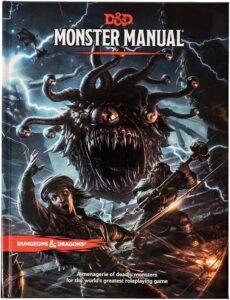During the long history of Dungeons & Dragons, Dungeon Masters and designers have sought ways to make monsters scary.
Well, scary to fight at least.
Sort of.
If you ask people about how combat should feel in the game, you’ll get a bunch of different answers. There is one strand that thinks that fighting is a failure state, and that combat should be incredibly deadly. Another strand thinks combat is fun and players should win all the time. And then you get all the variants of that.
Me? I think combat should be fun and plentiful, but every so often players should come up against scary monsters.
Energy Drain
Probably the scariest of the classic game mechanics was energy drain, also known as level drain. Basically, when you were struck by an energy drain monster, such as a wight, you lost a level of experience.
No saving throw: you just lost the level.
Vampires? They drained two levels of experience.
Could you recover from this? Well, there was the restoration spell, but that required a 16th-level cleric. With most games ending around 10th level, this was most unlikely.
It was easier to recover from death!
This is a controversial attack. Yes, it makes you fear the undead, but it can quickly lead to horrible circumstances – especially at higher levels where the suggested rate of increase is one or two levels per year of play!
Various abilities have been used over the years to give the same sense of dread, but without the long-term effects. In the current edition, you have monsters that reduce maximum hit points, with a Constitution saving throw to avoid the effect. This works quite well, especially as it also increases the chance of dying from a single hit. In one game of Death House, I saw a character wandering around with a maximum of 1 hit point! (A single hit for 2 hit points would kill him!) The flaw in this ability is typically that it’s too easy to recover from. One short or long rest and they all come back!
Charm and Domination
The original version of the charm person spell in original D&D has this text: “This spell applies to all two-legged, generally mammalian figures near to or less than man-size, excluding all monsters in the “Undead” class but including Sprites, Pixies, Nixies, Kobolds, Goblins, Orcs, Hobgoblins and Gnolls. If the spell is successful, it will cause the charmed entity to come completely under the influence of the Magic-User until such time as the “charm” is dispelled.”
Do you notice something interesting about this first-level spell? Yes, it doesn’t end. And the poor creature is completely under the Magic-User’s influence.
Every later edition – including AD&D – has sought to make this spell less powerful.
Domination is very much one of those “Content Warning” abilities, as sadly there are real world analogues – not magical, but terribly cruel. And you should be very mindful if used on the players’ characters – seeking consent is recommended.
It should be noted that some players find it amusing to attack their allies – or be attacked by them. I don’t think they’re wrong because it raises the stakes significantly. (And often they’re curious to see how they fare against the most terrible of monsters, the other player characters!)
Most of the current edition versions of dominate/charm effects are terribly anaemic, or even in cases when they have significant effects (such as dominate monster, an 8th level spell), they have serious drawbacks. In dominate monster’s case, you get advantage on the save if you’re fighting the caster. Interestingly, the spell doesn’t have a save at the end of each turn, but the affected creature does get to save if they are damaged.
Final Death
In Tomb of Horrors, the mouth of the demon holds a sphere of annihilation. Anything coming in contact with it is completely and irrevocably destroyed – no saving throw. In rare cases, you could find a free-floating sphere in dungeons, and magic-users had a chance to control its movement.
There aren’t that many examples of such abilities in the game. Completely destroying the character, especially one brought up over years, is enough to make more than a few players quit the game. The current version of the sphere is nowhere as terrifying. I wish it were more powerful.
Another way that a character that could meet the final death in AD&D and original D&D was by failing to be raised. There was a chance each time raise dead or a similar spell was cast that it wouldn’t work, and the character was permanently dead. In addition, the character’s constitution score was the maximum number of times they could be raised from the dead.
Gygax explained the rule in the AD&D Dungeon Masters Guide: “There MUST be some final death or immortality will take over and again the game will become boring because the player characters will have 9+ lives each!”
Later editions (including the Basic line) happily lived without this rule.
In MCDM’s Flee Mortals, demons have a final death ability. If one drops a character to 0 hit points, that character must make a saving throw. On a failure, their soul is devoured, and the character may never be raised or played again.
Final death mechanics are terribly dangerous to use in play. Consider the style of your campaign. If you’re running a story-based campaign, then they have not that much place there. But if the campaign is more player-directed, then they become more useful. Just as long as the players are aware that they exist in advance – suddenly telling a player “oh, your character’s soul was devoured, roll up a new character” doesn’t always go over well!

